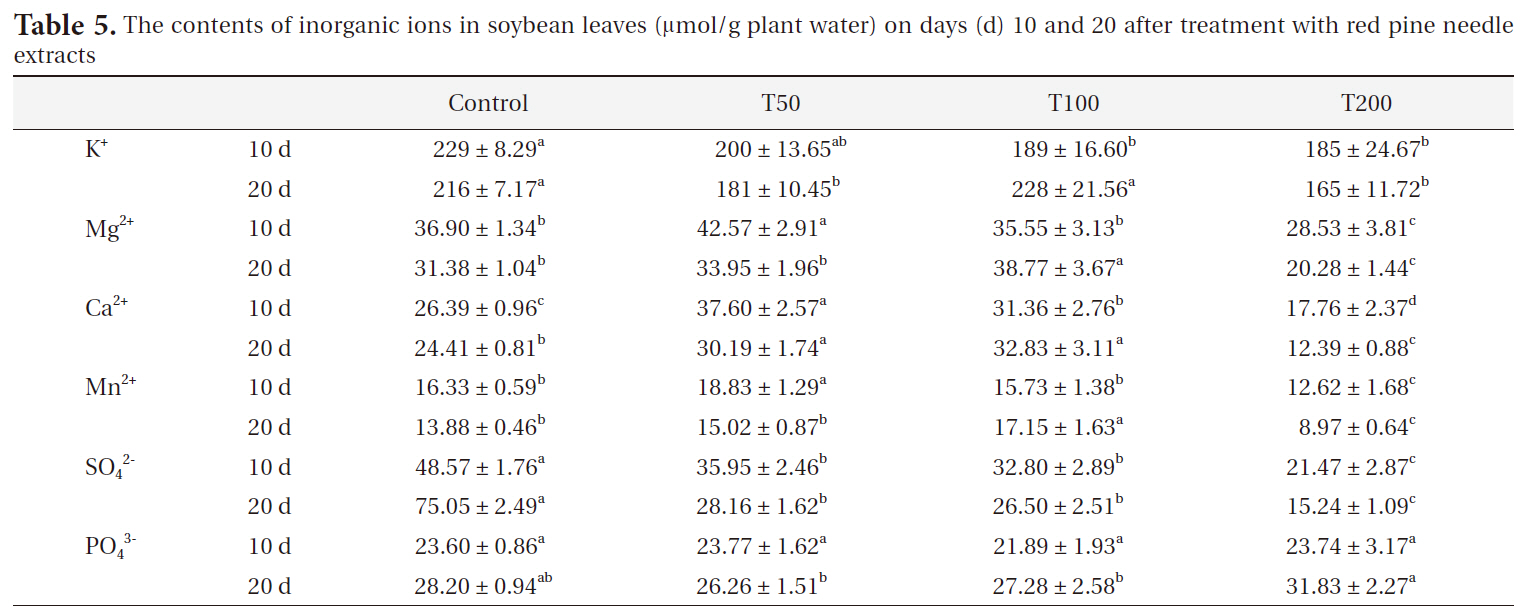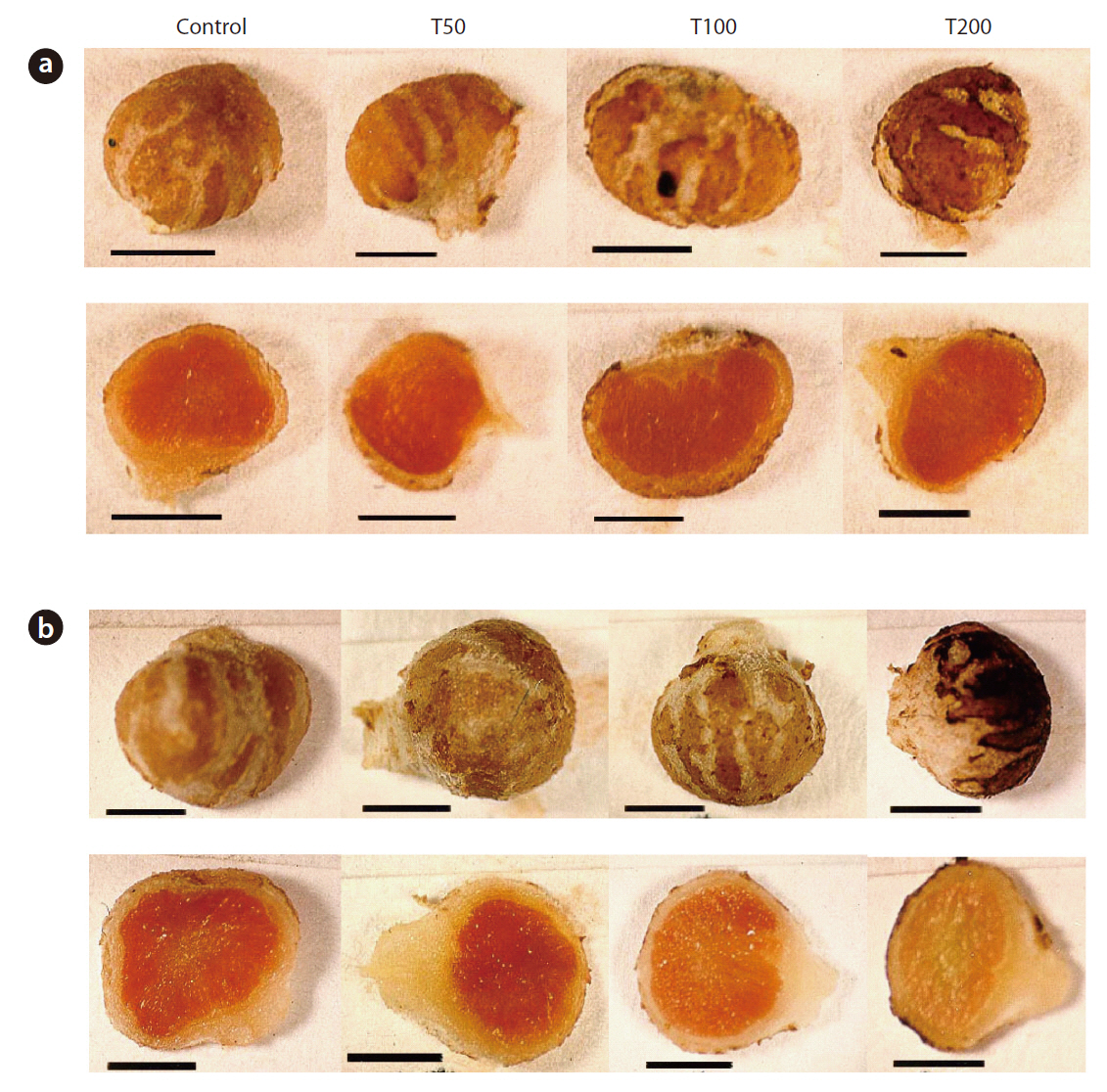



Red pine (
The objectives of this study were to identify differences in total phenolics (TP), osmolality, and total ions based on the quantity of red pine needles, and to understand allelopathic effects on plant growth by investigating nitrogen fixation activity of the root nodules, total nitrogen (TN) content, osmolality, total ions, and inorganic ion content in soybeans by red pine needle extract concentration and treatment period.
Fresh pine needles were collected from Korean red pine trees (
TP concentrations in the needle extracts were measured using Folin-Ciocalteu reagent, as described by Singleton and Rossi (1965) with gallic acid as a standard. The TP content was expressed as milligram of gallic acid equivalents per needle extract.
>
Plant material, growth conditions, and harvest
Uniform seeds of soybean obtained from the National Institute of Crop Science were soaked for 2 h in distilled water, and then one seed was sown per plastic pot (10 cm × 15 cm) filled with perlite in a growth chamber (30/20°C - day/night, relative humidity of 60/70% - day/night, 420 ㎛ol photons m-2 s-1, photoperiod of 12 h). Three pots per treatment concentration were used. Modified Hoagland’s solution was applied to the seedlings the second day after sowing. When the unifoliolated leaves were fully expanded, soybean nodule extract (5 g/L distilled water) was supplied at 100 mL per pot for 2 days to inoculate the soil with
>
Nitrogen fixation activity and TN content
The fresh roots of three plants from each treatment were collected and placed into 100 mL Erlenmeyer flasks with rubber stoppers; 0.1 atm of C2H2 (10 mL) was added and incubated at 30°C to determine N2-fixation activity. Gas samples (0.5 mL) were removed from the Erlenmeyer flasks with a 1 mL syringe at intervals of 1 h and analyzed for peak ethylene production using a gas chromatograph (GC-8 APF; Shimadzu, Kyoto, Japan) equipped with a H2-frame ionization detector and a Porapak R column (182 cm × 0.32 cm). Nitrogen fixation activity was calculated at a conversion ratio of 1.5:1 (acetylene reduced:N2 fixed) (Fishbeck et al. 1973). TN was determined by the micro-Kjeldahl method.
>
Determination of total ions, osmolality, and inorganic ions in needle extracts and soybean leave
Total ionic content (calculated as NaCl equivalents) was determined using a conductivity instrument (Mettler Check Mate 90; Mettler, Toledo, OH, USA), and the osmotic potential of the solutions was measured using an osmometer (Micro-Osmometer; Precision System Inc., Natick, MA, USA). K+, Mg2+, Ca2+, and Mn2+ were determined using inductively coupled plasma mass spectrometry (JY 38 plus; Jobin Yvon, Longjumeau, France). SO42- and PO43- were determined using ion chromatography under the following conditions: column, Star-ion A-300, 1,000 × 4.6 mm; eluent, 1.7 mM sodium hydrogen carbonate/11.8 mM sodium carbonate; flow rate, 1.5 mL/min.
>
Photography and data analysis
The surfaces and sections of nodules were observed with a stereoscope, and the results are shown as means ± standard errors of three independent replicates. Statistical analyses were conducted with one-way and two-way (concentration and period) analyses of variance. Duncan’s multiple range test was used to identify significant differences (

Changes in osmolality total ionic content total phenolic content and inorganic ion content in red pine needle extracts adjusted to pH 5.0

Comparison of dry weights (DW) (g) and total nitrogen (TN) content (g) in soybean leaves on days (d) 10 and 20 after treatment with red pine needle extracts
>
Chemical characteristics of the needle extracts
Total phenolics, osmolality, total ions, K+, Mg2+, Ca2+, and PO43- of red pine needle extracts were higher than those of the control, and these values increased with an increase in the amount of needles added. However, the opposite trend was observed for SO42- content (Table 1).
>
Effect on growth and physiological characteristics
After day 10, treatment with the needle extract resulted in a significant reduction in DW of leaves, but no significant differences were found within the treatment groups. A significant decrease in leaf production based on the needle extract concentrations was observed after day 20 of treatment and the DWs of the leaves in the T50, T100, and T200 concentration groups decreased by 12.8%, 38.3% and 53.8% compared with the control, respectively (Table 2). Treatment with the needle extracts resulted in a significant reduction in TN after day 20. TN content decreased significantly with the two highest extract con-
centrations by 50.8% and 57.4% compared with that in the control, after days 10 (Table 2). The T100 and T200 extract concentrations inhibited nodule DW and total nitrogen fixation activity (TNA) (Table 3). However, nodule DW and TNA were not significantly different compared with those in the control for the lowest extract concentration, except for TNA on day 10 of treatment. The surface of the nodules exposed to the extract was discolored brown to black, and the inner color of the nodules faded gradually in comparison with that in the control, except for the nodules treated with the T50 extract (Fig. 1).
>
Osmolality and total ionic content
After day 10 of treatment, soybean osmolality increased following addition of the needle extracts and was highest for the T200 concentration. However, a significant increase in osmolality was observed for the T100 treatment after day 20 of treatment (Table 4). Total ionic content was not significantly different between the control and all treatments after 10 days. However, total ionic content in all treatment groups decreased significantly compared with the control after day 20 of treatment. The lowest total ionic content value occurred in plants exposed to the T200 concentration (Table 4).
Soybeans showed different trends for inorganic ion content based on the extract treatment concentration and treatment period (Table 5). The contents of Mg2+, Ca2+, and Mn2+ were higher than those of the control in plants treated with the T50 concentration on day 10 and for those treated with the T100 concentration on day 20 after treatment. The highest K+ value occurred in the control after day 10 of treatment and in the control and

Total number of nodules dry weight of nodules (g) and total nitrogen fixation activity (TNA μM C2H4 plant-1 1 h-1) of soybean root nodules on days (d) 10 and 20 after treatment with red pine needle extracts

Osmolality (μosm/g plant water) and total ionic content (μeq/g plant water) in soybean leaves on days (d) 10 and 20 after treatment with red pine needle extracts

The contents of inorganic ions in soybean leaves (μmol/g plant water) on days (d) 10 and 20 after treatment with red pine needle extracts
T100 concentration plants after day 20. Among the inorganic ions, SO42- content decreased significantly with an increase in extract concentration. SO42- content was reduced by 55.8% and 79.7% compared with that in the control for plants in the T200 treatment group after days 10 and 20, respectively. After day 10, PO43-content in all treatment groups was not significantly different compared with that in the control. However, PO43- content in plants exposed to the T200 concentration was higher than that of the T50 and T100 concentration after day 20 of treatment.
Applying red pine needle extracts resulted in physiological changes to nitrogen fixation activity of the root nodules, TN content, osmolality, and total ionic contents in soybean leaves. Growth inhibition was considered to be due to allelochemicals in the needle extracts (Kil 1989, Kato-Noguchi et al. 2009) or related to the concentration of phenolic compounds in the mixture as well as the treatment duration (Alsaadawi et al. 1986, Inderjit et al. 2002).
Adding red pine needles to the nutrient solution resulted in an increase in osmolality and total ions as well as total phenolic content (Table 2). All aqueous plant extracts will exert negative osmotic and allelochemical effects on test plants (Bell 1974). In the present study, K+, Mg2+, Ca2+, and PO43- and total phenolic content increased with increasing needle quantity added to the nutrient solution, which was correlated with the increase in total ionic content, but SO42- content decreased. Phenolics have significant effects on nutrient cycling by forming nutrient complexes (Appel 1993). This suggests that phenolics released from the pine needles may have affected SO42- availability to the soybean and reduced SO42- content in the leaves. Despite the increase in total ionic content, K+, Mg2+, Ca2+ and PO43- content in the needle extract and the contents of inorganic ions in the leaves of the treated plants showed different patterns according to the treatment concentration and duration. Phenolic compounds can cause depolarization of plant membranes and peroxidation of membrane lipids, which leads to the disruption of water balance and perturbations in ion uptake at the roots (Lyu and Blum 1990, Barkosky and Einhellig 1993, Baziramakenga et al. 1995). Therefore, changes in total leaf ions and inorganic ions could be explained as a consequence of alterations in membrane function by allelochemicals in the pine needle extracts.
Nitrogen nutrition in soybeans is ensured by both nitrogen fixation and nitrogen mineral assimilation, as in other legumes (Appleby 1984). Rice et al. (1981) reported that phenolic compounds reduce both nodule numbers and leghemoglobin content of nodules in two bean (
In conclusion, the DWs and TN of soybean were reduced by a red pine needle extract, indicating that allelochemicals within the red pine needle extract may have a negative effect on soybean growth. The extent of growth inhibition was related to the concentration of phenolic compounds in the extract and treatment duration. Total nodule number and nodule DW were not affected by the low phenolic compound concentration. TN activity and the low concentration of phenolic compounds resulted in a significant decrease in nitrogen fixation compared with the control after day 10 of treatment, but was not affected when soybeans were exposed for a long duration, indicating that the low concentration of phenolic compounds had a positive effect on nitrogen fixation activity. Under severe allelochemical stress conditions, a significant reduction in nodule formation, nitrogen fixation activity, and ion uptake resulted in a reduction in plant growth. The change in ion fluxes and the accumulation of osmotic solutes in soybeans exposed to lower pine needle extract concentrations than a critical level may help to overcome allelopathic stress and maintain plant growth against allelochemical exposure.





